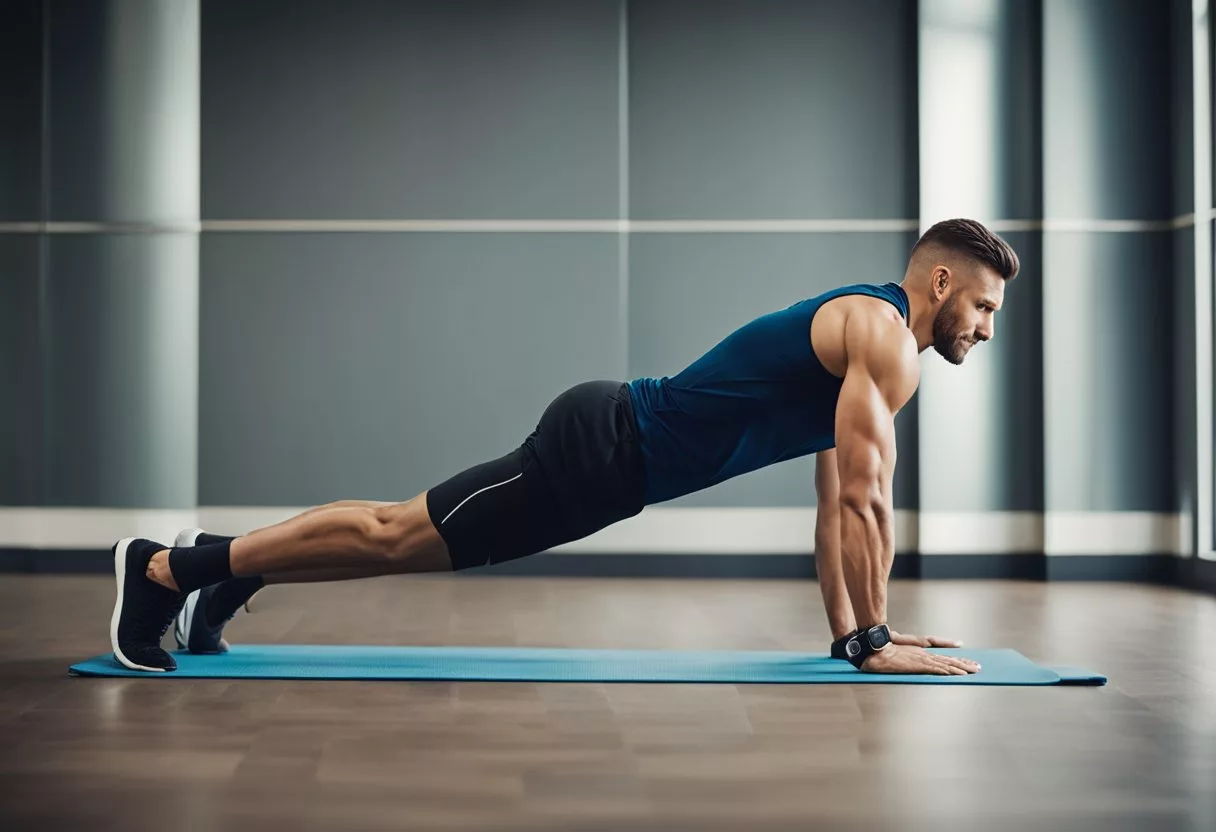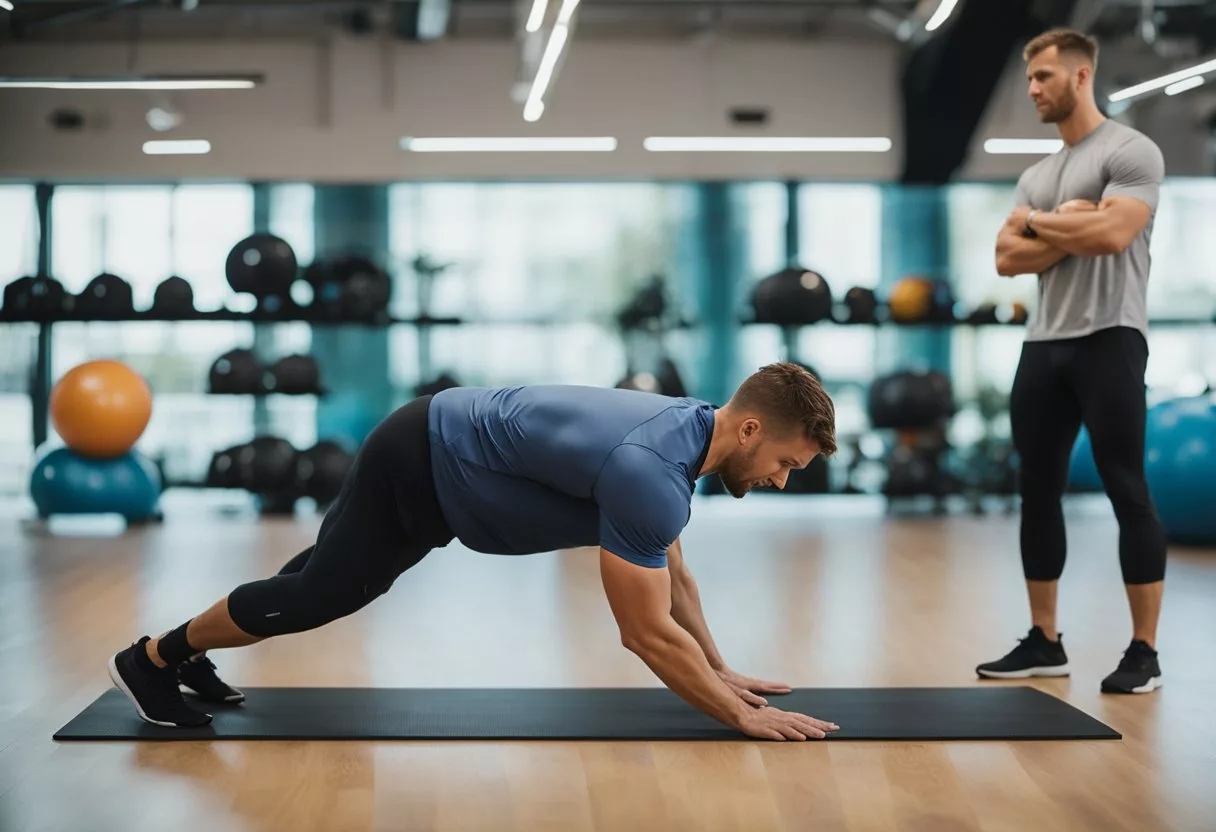Facing diastasis recti can be challenging for men. Progressive core strengthening plans can provide significant relief and improvement. Diastasis recti, often thought to be a condition primarily affecting women postpartum, equally impacts men. It involves the separation of the abdominal muscles, resulting in a gap that can lead to core weakness, poor posture, and back pain.
By following targeted exercises and supportive strategies, men can effectively address diastasis recti and regain core strength. These strength-training routines not only help in closing the muscle gap but also enhance overall functional fitness. Understanding the right techniques and avoiding movements that cause excessive abdominal pressure are key to successful rehabilitation.
A well-structured core strengthening plan focuses on safe and gradual exercises. It ensures the correct engagement of the abdominal muscles, promotes healing, and prevents further injury. This article outlines essential exercises and tips to help men overcome diastasis recti and improve their quality of life.
Key Takeaways
- Progressive core strengthening is crucial for managing diastasis recti in men.
- Proper exercise techniques can improve core strength and posture.
- Consistent practice and lifestyle adjustments can prevent recurrence.
Understanding Diastasis Recti in Men

Diastasis recti in men is marked by a gap or bulge in the middle of the abdomen due to the separation of the abdominal muscles. This condition affects the connective tissue and can be caused by various factors including heavy lifting and rapid weight gain.
Defining Diastasis Recti
Diastasis recti occurs when there is a separation between the left and right sides of the abdominal muscles. This results in a gap that can create a bulge in the midsection. The condition is often visible when the muscles are strained. In men, this separation can be caused by activities that put pressure on the abdomen, such as weightlifting or excessive abdominal exercises.
The Anatomy Involved
The key element in diastasis recti is the linea alba, a strip of connective tissue that runs down the center of the abdomen. This tissue holds the abdominal muscles together. When the linea alba becomes overstretched, it loses its ability to keep the muscle edges close together, leading to a gap. The abdominal muscles involved include the rectus abdominis, which are the “six-pack” muscles, and they are essential for core stability.
Common Causes and Risk Factors
Several risk factors contribute to developing diastasis recti in men. One common cause is excessive abdominal pressure from heavy lifting or intense physical exercise. Rapid weight gain, especially around the abdominal area, can also be a significant factor.
Other causes may include improper exercise form, previous abdominal surgeries, or chronic straining, such as that seen in individuals with chronic coughing or constipation. These factors can weaken the connective tissue, making diastasis recti more likely.
Identifying Symptoms and Diagnosis
Men with diastasis recti typically notice a bulge or ridge running down the middle of the abdomen. This bulge is more noticeable during an activity that strains the abdominal muscles, such as sitting up from a lying position. Other symptoms may include lower back pain, poor posture, and a sense of weakness in the midsection.
Diagnosing diastasis recti often involves a physical examination. A common test involves lying on the back and attempting to lift the head and shoulders slightly off the ground. If a gap or bulge is observed along the midline, it is likely diastasis recti. Doctors may also use imaging techniques, such as ultrasound, to assess the degree of muscle separation.
The Impact of Core Strength on Diastasis Recti
Strengthening the core muscles plays a vital role in addressing diastasis recti. A strong core helps improve posture, balance, and reduces back pain, contributing to overall well-being.
Role of Core Muscles
The core muscles include the transverse abdominis, rectus abdominis, obliques, and deep core muscles like the pelvic floor and diaphragm. They support the spine and maintain stability during movement. Diastasis recti occurs when the rectus abdominis muscles separate, often due to increased pressure and weak supportive muscles.
These muscles are crucial for maintaining a strong midsection and preventing excessive abdominal strain. For men, a robust core ensures better functional movement and reduces the risk of injury during physical activities.
Complications Due to Weak Core
A weak core can exacerbate diastasis recti. When core muscles lack strength, they fail to support the abdominal wall effectively. This can lead to poor posture and put additional stress on the lower back, causing chronic pain.
Weak core muscles can also compromise balance, leading to a higher risk of falls and injuries. For individuals with diastasis recti, inadequate core strength can impede healing and further widen the separation of the abdominal muscles.
Benefits of Strengthening Core Muscles
Strengthening the core muscles offers significant benefits for those with diastasis recti. Enhanced core strength improves posture by aligning the spine correctly. It reduces back pain by alleviating undue pressure on the lumbar region.
Better core strength also means improved balance and stability, which are crucial for everyday tasks and physical activities. Specific exercises targeting the deep core muscles can help close the gap in the abdominal wall and promote healing. For instance, abdominal bracing is effective for activating lateral abdominals without increasing pressure on healing muscles.
Designing a Progressive Core Strengthening Plan

A progressive core strengthening plan for diastasis recti in men involves starting with basic exercises and gradually increasing difficulty to build core strength and stability. This approach helps ensure safety and effectiveness in restoring core function.
Basics of a Progressive Approach
To design a progressive core strengthening plan, it’s essential to understand the nature of diastasis recti and the importance of starting slowly. Diastasis recti is when abdominal muscles separate, often due to high pressure on the abdomen from activities like heavy lifting or weight gain.
Beginners should focus on gentle core exercises that avoid additional strain on the abdominal muscles. Exercises should be done consistently and slowly advanced as strength and stability improve. Wearing supportive gear and maintaining good posture can also help during the workout routine to avoid aggravating the condition.
Recommended Exercises for Beginners
For those new to core strengthening, starting with safe and gentle exercises is crucial. The heel slide is an effective exercise that targets deep core muscles. To perform the heel slide, lie on your back with knees bent and feet flat, then brace your abdomen and slide one heel along the floor until the leg straightens.
Another helpful exercise is the abdominal brace. To do this, lie on your back, bend your knees, and tighten your abdominal muscles as if preparing for a punch to the stomach. Hold this position for a few seconds, then relax.
Pelvic tilts are also valuable. Lie on your back with knees bent and feet flat, then gently tilt your pelvis upward by tightening your abdominal muscles. Hold, then return to the start position. Consistency with these exercises is key to gradually building core strength.
Advanced Core Strengthening Exercises
As strength and stability improve, more advanced exercises can be incorporated. Planks are excellent for building core strength without stressing the abdominal separation. Begin with a modified plank by supporting your weight on knees and forearms. Over time, progress to full planks on toes and forearms.
Side planks help target the oblique muscles while supporting overall core stability. Start with knees bent for support and eventually move to a straight-leg position. Bird-Dog exercises also provide an advanced challenge, involving lifting opposite arm and leg simultaneously while on hands and knees, maintaining a stable core throughout.
Exercise Technique and Considerations
Performing exercises for diastasis recti requires attention to correct form and alignment, adjusting intensity and volume appropriately, and avoiding common mistakes.
Correct Form and Alignment
Maintaining proper form and alignment during exercises is essential to avoid further damage and ensure effective muscle engagement. For instance, during a heel slide exercise, the individual should lie on their back with knees bent and feet flat on the floor. This position helps maintain spine neutrality and supports the lower back.
It’s crucial to engage the core correctly before starting each movement. Performing an abdominal brace, which involves tightening the abdominal muscles without holding your breath, can support the spine. Focusing on a slow and controlled movement enhances the effectiveness and safety of the exercise.
Adjusting Intensity and Volume
The intensity and volume of workouts should be tailored to the individual’s progress and physical condition. Beginners may start with low-intensity exercises, gradually increasing the difficulty as their core strength improves. For example, starting with 5-10 repetitions of gentle pelvic tilts and progressing to more challenging movements like the bear plank is advisable.
It’s important to listen to the body and avoid overexertion. Slowly increasing the number of sets and repetitions helps prevent undue strain on the diastasis recti. Monitoring fatigue levels and taking adequate rest between exercise sessions ensures effective recovery and muscle adaptation.
Avoiding Common Mistakes
One common mistake is performing exercises that strain the rectus abdominis, such as sit-ups or crunches, which can exacerbate diastasis recti. Alternative exercises like transverse abdominis activation and pelvic floor strengthening should be prioritized.
Incorrect breathing techniques, such as holding breath during movement, can also hinder progress. Proper breathing, which involves exhaling during exertion and inhaling during relaxation, supports core engagement and reduces intra-abdominal pressure. Avoid lifting heavy weights initially; instead, focus on body-weight exercises until sufficient core strength is developed.
Healing and Recovery Strategies

Healing from diastasis recti involves targeted exercises and non-exercise interventions to ensure complete recovery. Professional therapy also plays a significant role in this process.
Non-Exercise Interventions
Non-exercise interventions include wearing specialized support garments like the diastasis rehab splint. This helps in providing support and aligning the abdominal muscles effectively.
Adopting a balanced diet is essential for overall health and tissue healing. Adequate protein intake aids muscle repair.
Rest is another crucial component. Avoid any activities that strain the abdominal area, particularly those that involve heavy lifting or intense core engagement.
Monitoring posture alignment prevents undue pressure on the abdominal area. Correct standing, sitting, and lifting techniques can reduce additional strain.
Role of Professional Therapy
A physical therapist trained in treating diastasis recti can be invaluable. They provide a personalized exercise program tailored to the individual’s needs, ensuring exercises are performed correctly to avoid further injury.
Techniques like the Tupler Technique focus on specific breath patterns and core movements to recondition the muscles.
Consistent therapy sessions can monitor progress and adjust the program as needed.
Furthermore, therapists may use manual therapies, such as myofascial release, to improve tissue mobility and reduce tension in the muscles.
Managing Lifestyle for Better Outcomes

A holistic approach to managing diastasis recti in men involves several key lifestyle changes. These changes focus on nutrition, weight management, and incorporating specific daily activities to improve overall core strength.
Nutritional Considerations
Diet plays a critical role in managing diastasis recti. Eating a balanced diet rich in vitamins and minerals supports muscle repair and overall health. Foods high in protein, such as lean meats, beans, and nuts, can aid in muscle recovery.
Additionally, staying hydrated is essential. Water helps maintain muscle elasticity and reduces inflammation. Including fiber-rich foods like vegetables, fruits, and whole grains can prevent constipation. This minimizes the strain on the abdominal muscles caused by bearing down.
Cutting down on processed foods and sugars can also help in weight management, which is crucial for men dealing with diastasis recti.
Role of Weight Management
Maintaining a healthy weight is vital. Excess weight, especially around the abdomen, puts extra pressure on the abdominal muscles. This can worsen diastasis recti. Regular physical activity, coupled with a balanced diet, helps in maintaining an ideal weight.
Avoid rapid weight gain, as it can contribute to the condition. Simple exercises like walking or swimming can be beneficial. They improve cardiovascular health and support weight loss without stressing the core. Additionally, avoiding heavy lifting and exercises like flutter kicks that exert too much pressure on the abdomen is important.
Men should strive for gradual weight loss, integrating low-impact physical activities to support their fitness journey.
Incorporating Daily Activities
Incorporating specific daily activities helps manage diastasis recti. Gentle core-strengthening exercises, such as heel slides and pelvic tilts, can stabilize the core. Performing these exercises regularly and correctly is key for best results.
Proper posture while sitting and standing reduces unnecessary strain on the abdominal muscles. Men can also engage in mindful practices like yoga. Certain poses help strengthen the core without causing harm. Avoid deep yoga backbends like the upward bow, which can exacerbate the condition.
Simple lifestyle modifications, like engaging the core during daily activities like coughing or bending, can aid in managing the condition effectively.
Preventing Recurrence and Further Injury

To help ensure that diastasis recti does not recur or worsen, it is crucial to focus on maintaining strong core muscles and developing habits that support long-term health. This involves both preventative measures and consistent routines.
Importance of Maintenance Routines
Maintenance routines play a critical role in preventing the recurrence of diastasis recti. Regular core-strengthening exercises should be integrated into daily life. Exercises like pelvic tilts, heel slides, and gentle core bracing can help maintain strength. It’s important that these exercises are performed correctly to avoid unnecessary strain.
Tracking progress through a structured routine can lead to better compliance. Utilizing a planner or a fitness app makes it easier to stick to the routine. Rest days are also essential to allow the muscles to recover and strengthen.
Listening to the body’s signals is crucial. Any signs of pain or discomfort should be addressed immediately by modifying the exercise or consulting a professional.
Developing Long-term Habits
Incorporating long-term habits can significantly reduce the risk of recurrence. Practicing good posture helps in maintaining proper alignment and minimizes undue pressure on the abdomen. Activities, such as lifting heavy objects, should be approached with caution and proper technique to prevent strain.
Monitoring weight gain is also important. Excessive weight, especially around the midsection, can strain the abdominal muscles. Regular check-ins with a healthcare professional can offer guidance and adjustments to both diet and exercise plans.
Small but consistent modifications to daily activities, such as ensuring ergonomic workspaces and using supportive footwear, can make a big difference. These efforts combined create a healthier and more resilient core over time.
Advanced Topics and Research
This section explores the latest developments in core training for men with diastasis recti, including current trends and emerging therapies and techniques aimed at improving core strength and reducing symptoms.
Current Trends in Core Training
Recent research highlights several trends in core training aimed at effectively managing diastasis recti in men. One significant trend is the focus on dynamic core stability exercises, such as planks and variations that engage multiple muscle groups without putting excessive strain on the abdominal separation. Studies have compared dynamic core stability exercises with traditional supine core stability programs, finding positive outcomes in reducing diastasis recti (source).
Another trend is the integration of functional movement patterns into core workouts. These exercises reflect daily activities and sports routines, thereby improving overall muscle coordination and strength. Incorporating functional movements helps in engaging the transverse abdominis and pelvic floor muscles, essential for stabilizing the core and minimizing diastasis recti.
Technology-enhanced training, including the use of biofeedback and smart wearables, is also gaining traction. These tools provide real-time feedback on muscle engagement and posture, ensuring that exercises are performed correctly and effectively.
Emerging Therapies and Techniques
Emerging therapies for diastasis recti in men include a combination of traditional exercises and innovative approaches. Physical therapy regimens have evolved to include specialized programs tailored to individual needs, focusing on both core and pelvic floor strengthening. These regimens aim at reducing the gap between the abdominal muscles and improving overall function.
Surgical options are considered for severe cases where exercises alone are insufficient. Techniques like abdominoplasty can physically correct the separation, although these are generally reserved for cases where non-surgical methods have failed (source).
Non-invasive techniques such as electrical muscle stimulation (EMS) are also being explored. EMS can target and activate deep core muscles that are difficult to engage through regular exercises alone. This technique is beneficial for those who may struggle with traditional exercise methods due to pain or mobility issues.
Finally, holistic approaches combining physical exercise with nutritional guidance are becoming popular. Proper nutrition aids in muscle recovery and overall health, which is crucial for anyone undergoing core strengthening programs for diastasis recti.
Frequently Asked Questions
Men experiencing diastasis recti often have questions about which exercises are beneficial and which should be avoided. This section addresses common inquiries about treating, managing, and reversing diastasis recti through targeted core-strengthening programs.
What are the best exercises to repair diastasis recti in men?
Effective exercises include:
- Quadruped Tilts: Begin on hands and knees. Slowly exhale, draw the lower abdomen in, and tuck the pelvis under. Hold and return to a neutral position. Repeat 5 to 10 times.
- Side Planks: Lie on your side with your elbow under your shoulder. Lift hips until aligned with the body, then hold.
These exercises help in gradually building core strength without overexerting the abdominal muscles.
Are there any exercises to avoid for men with diastasis recti?
Yes, certain exercises can worsen diastasis recti. Avoid:
- Supine Double Leg Lower
- Flutter Kicks
- Sit-ups / V-ups
- Deep extension yoga poses like upward bow and camel
These activities put too much pressure on the abdominal region, which can aggravate the separation.
Can diastasis recti in men be effectively treated without surgery?
Diastasis recti can often be managed and improved through specific core-strengthening exercises. While severe cases might require surgical intervention, many men find significant relief and improvement with a dedicated workout plan tailored to their condition.
How can men progressively strengthen their core after a diastasis recti diagnosis?
Start with gentle, low-impact exercises like pelvic tilts and side planks. Gradually increase intensity as strength and stability improve. Consistent practice and proper technique are key. Regularly check progress and adjust exercises based on comfort and muscle response.
Is it possible to reverse diastasis recti in men through exercise?
With consistent and targeted exercises, many men can reduce the gap between their abdominal muscles. While completely reversing diastasis recti varies from person to person, regular and focused core workouts often lead to significant improvement.
What are the recommended core strengthening activities for men with diastasis recti?
Recommended activities include:
- Standing pelvic tilts
- Modified side planks
- Gentle stretching and breathing exercises
These activities focus on rebuilding core stability and strength. They don’t put undue pressure on the abdominal area. Regular practice can help in managing and mitigating the symptoms of diastasis recti.